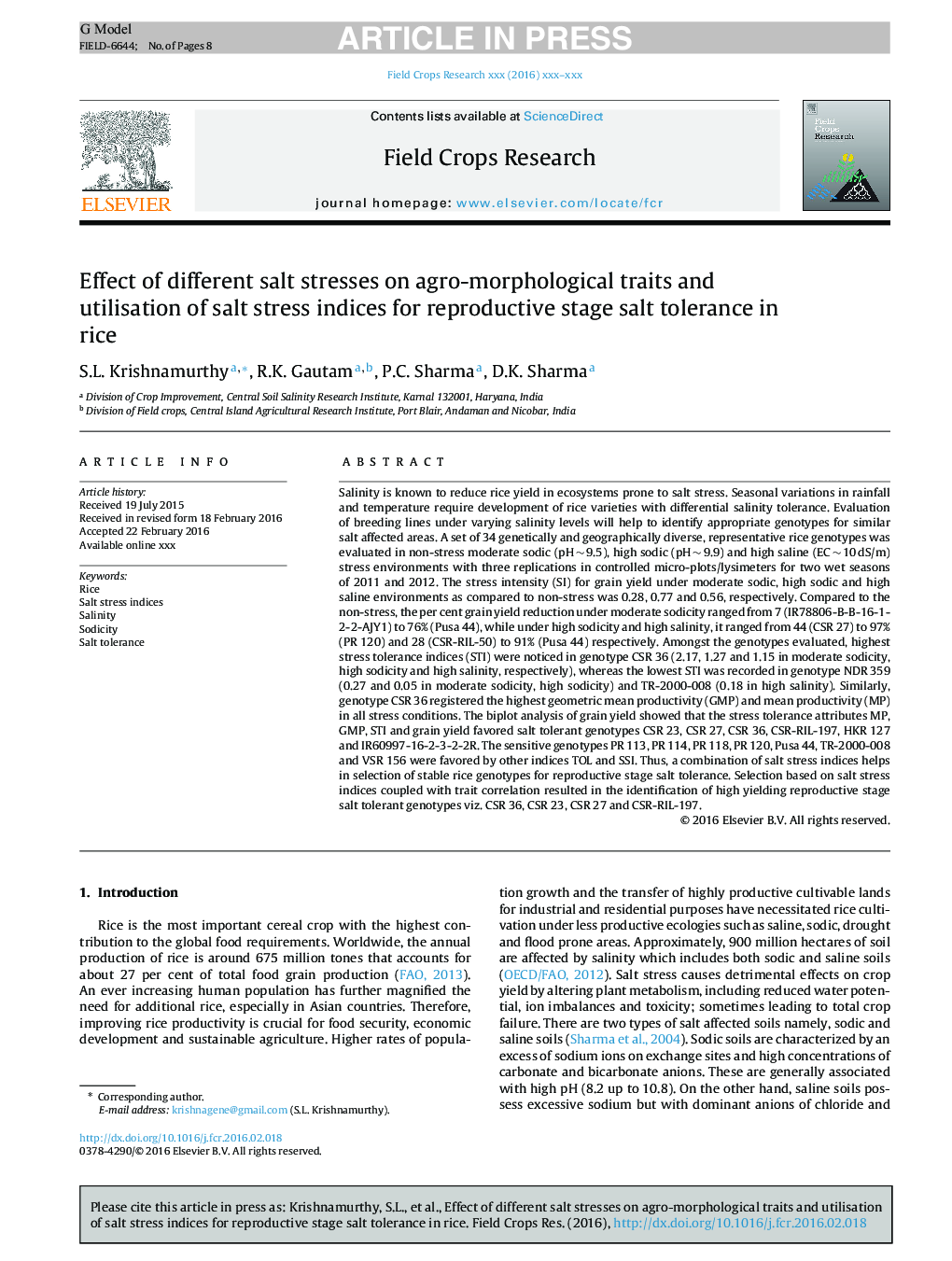| کد مقاله | کد نشریه | سال انتشار | مقاله انگلیسی | نسخه تمام متن |
|---|---|---|---|---|
| 6374467 | 1624673 | 2016 | 8 صفحه PDF | دانلود رایگان |
عنوان انگلیسی مقاله ISI
Effect of different salt stresses on agro-morphological traits and utilisation of salt stress indices for reproductive stage salt tolerance in rice
ترجمه فارسی عنوان
اثر تنش شوری مختلف بر صفات زراعی و مورفولوژیک و استفاده از شاخص های تنش شوری در تحمل شوری باروری در برنج
دانلود مقاله + سفارش ترجمه
دانلود مقاله ISI انگلیسی
رایگان برای ایرانیان
کلمات کلیدی
برنج، شاخص های تنش نمک، شوری سعادت، تحمل نمک،
موضوعات مرتبط
علوم زیستی و بیوفناوری
علوم کشاورزی و بیولوژیک
علوم زراعت و اصلاح نباتات
چکیده انگلیسی
Salinity is known to reduce rice yield in ecosystems prone to salt stress. Seasonal variations in rainfall and temperature require development of rice varieties with differential salinity tolerance. Evaluation of breeding lines under varying salinity levels will help to identify appropriate genotypes for similar salt affected areas. A set of 34 genetically and geographically diverse, representative rice genotypes was evaluated in non-stress moderate sodic (pH â¼Â 9.5), high sodic (pH â¼Â 9.9) and high saline (EC â¼Â 10 dS/m) stress environments with three replications in controlled micro-plots/lysimeters for two wet seasons of 2011 and 2012. The stress intensity (SI) for grain yield under moderate sodic, high sodic and high saline environments as compared to non-stress was 0.28, 0.77 and 0.56, respectively. Compared to the non-stress, the per cent grain yield reduction under moderate sodicity ranged from 7 (IR78806-B-B-16-1-2-2-AJY1) to 76% (Pusa 44), while under high sodicity and high salinity, it ranged from 44 (CSR 27) to 97% (PR 120) and 28 (CSR-RIL-50) to 91% (Pusa 44) respectively. Amongst the genotypes evaluated, highest stress tolerance indices (STI) were noticed in genotype CSR 36 (2.17, 1.27 and 1.15 in moderate sodicity, high sodicity and high salinity, respectively), whereas the lowest STI was recorded in genotype NDR 359 (0.27 and 0.05 in moderate sodicity, high sodicity) and TR-2000-008 (0.18 in high salinity). Similarly, genotype CSR 36 registered the highest geometric mean productivity (GMP) and mean productivity (MP) in all stress conditions. The biplot analysis of grain yield showed that the stress tolerance attributes MP, GMP, STI and grain yield favored salt tolerant genotypes CSR 23, CSR 27, CSR 36, CSR-RIL-197, HKR 127 and IR60997-16-2-3-2-2R. The sensitive genotypes PR 113, PR 114, PR 118, PR 120, Pusa 44, TR-2000-008 and VSR 156 were favored by other indices TOL and SSI. Thus, a combination of salt stress indices helps in selection of stable rice genotypes for reproductive stage salt tolerance. Selection based on salt stress indices coupled with trait correlation resulted in the identification of high yielding reproductive stage salt tolerant genotypes viz. CSR 36, CSR 23, CSR 27 and CSR-RIL-197.
ناشر
Database: Elsevier - ScienceDirect (ساینس دایرکت)
Journal: Field Crops Research - Volume 190, April 2016, Pages 26-33
Journal: Field Crops Research - Volume 190, April 2016, Pages 26-33
نویسندگان
S.L. Krishnamurthy, R.K. Gautam, P.C. Sharma, D.K. Sharma,
